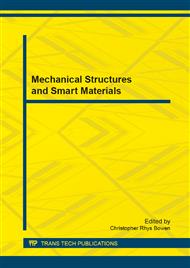[1]
J.R. Fisher, R.F. Bradley, W.D. Cotton etc, Large Instrument Development for Radio Astronomy, Astro2010: The Astronomy and Astrophysics Decadal Survey, Technology Devlopment Papers. (2009).
Google Scholar
[2]
Yogesh Maan, Avinash A. Deshpande, Vinutha Chandrashekar etc, RRI-GBT Multi-Band Receiver: Motivation, Design, and Development, The Astrophysical Journal Supplement Series. 204(2013)12.
Google Scholar
[3]
J. Ruze, The Effect of Aperture Errors on the Antenna Radiation Pattern, Air Force Cambridge Research Center. 9(1952)364-380.
DOI: 10.1007/bf02903409
Google Scholar
[4]
Li N, Duan B Y, Zheng F, Effect of the Random Error on the Radiation Characteristic of the Reflector Antenna Based on Two-Dimensional Fractal, International Journal of Antennas and Propagation. (2012).
DOI: 10.1155/2012/543462
Google Scholar
[5]
YANG D H, Daniel Okoh, ZHOU G H etc, Panel Positioning Error and Support Mechanism for a 30-m THz Radio Telescope, Research in Astronomy and Astrophysics. 11(2011)725-736.
DOI: 10.1088/1674-4527/11/6/011
Google Scholar
[6]
S. von Horner, Woon-Ying Wong, Gravitational Deformation and Astigmatism of Tiltable Radio Telescopes, IEEE Transactions on Antennas and Propagation. 23(1975)689-695.
DOI: 10.1109/tap.1975.1141163
Google Scholar
[7]
Wei Wang, Baoyan Duan, Boyuan Ma, A Method for Panel Adjustment of Large Reflector Antenna Surface and Its Application, Acta Electronica Sinica. 36(2008)1115-1118.
Google Scholar
[8]
Yucedag OM, Turk AS, Parametric design of Open Ended Waveguide Array Feeder with Reflector Antenna for Switchable Cosecant-Squared Pattern, Applied Computational Electromagnetics Society Journal, 27(2012)668-675.
DOI: 10.1109/mikon.2012.6233523
Google Scholar
[9]
CHEN S X, The Analysis, Synthesis and Optimization of Engineering Structure System, China Science Culture Publishing House, China, (2008).
Google Scholar
[10]
Otto Hachenberg, B.H. Grahl, R. Wielebinski, The 100-Meter Radio Telescope at Effelsberg[J], Proceedings of the IEEE. 61(1973)1288-1295.
DOI: 10.1109/proc.1973.9262
Google Scholar
[11]
Balemir Uragun, Ramesh Rajan, Developing an Approriate Data Normalization Method, 2011 10th International Conference on Machine Learning and Applications. 2(2011)195-199.
DOI: 10.1109/icmla.2011.53
Google Scholar
[12]
K. Schittkowski, NLPQL: A Fortran Subroutine Solving Constrained Nonlinear Programming Problems, Annals of Operations Research. 5(1985)485-500.
DOI: 10.1007/bf02022087
Google Scholar
[13]
HAO C L, LIU X W, Global Convergence of an SQP Algorithm for Nonlinear Optimization with Overdetermined Constriants, Numerical Algebra, Control and Optimization, 2(2012)19-29.
DOI: 10.3934/naco.2012.2.19
Google Scholar
[14]
HUANG P, MENG Y G, Optimal Theories and Methods, Tsinghua University Press, Beijing, (2002).
Google Scholar


